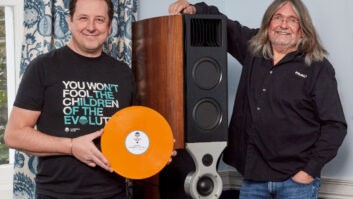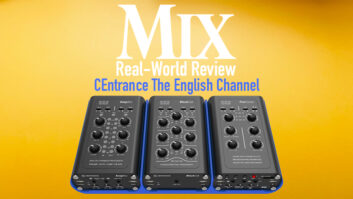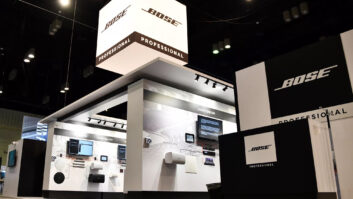by Janice Brown
New York, NY (January 2006)–I’m certainly one of “the masses” Digidesign expected to reach when its parent company acquired M-Audio, forging a synergy that has yielded the recent and very accessible Pro Tools M-Powered software release. With the purchase of an affordable M-Audio USB or FireWire-driven hardware interface, the average laptop can be transformed into a full-on music production studio and hard disc recorder. For example, M-Audio’s Ozonic audio interface and MIDI keyboard controller connected via FireWire to my Apple G4 PowerBook running Pro Tools M-Powered 6.8 has made an ideal first studio.
M-Audio OzonicGetting set-up, I started with a brand-new PowerBook, with 1.5 GHz PowerPC processor and running OS 10.4.2, and a laundry list of installations, between the Ozonic driver, Pro Tools M-Powered, Ableton Live Lite 4, which came bundled with the Ozonic (a recent update bundles Live Lite 5), and my other choice sequencers, Propellerheads Reason 3.0 and Logic Express 7. Installing the M-Audio Ozonic driver on my PowerBook was speedy and straight-forward, and would presumably be so for a PC user, as the unit also comes with the driver software and instructions for installation on Windows XP.
After installing the driver and shutting down the computer, I connected the Ozonic directly into the FireWire port on my G4 using the supplied FireWire cable, plugged the keyboard’s AC adapter into a nearby outlet, and restarted. A quick look in my Systems Preferences folder and into my Audio MIDI Setup assured the Ozonic was hooked up and ready to go. Likewise, after loading and launching Pro Tools M-Powered and Ableton Live Lite, the Ozonic was automatically assigned as my I/Os and MIDI controller. On occasion after the initial install, the Preferences had to be revisited in both Reason and Logic Express, to reset the Ozonic as my control surface & keyboard, audio card and driver.
When working with the Ozonic, I monitored either on headphones, plugged directly into the 1/4″ headphone jack on the Ozonic’s back panel, or on my M-Audio Studio Pro 4 monitors via the same headphone jack. Headphones also plug directly into a 1/8″ output jack on the front of the left speaker so I could easily switch between the monitors and headphones. The synth-action keyboard, with +/- 4 octave and transpose buttons, paired with the amazing array of virtual instruments and soft samplers in Reason, Logic and Live, transformed me pretty quickly into an electronic songwriter, beat-maker, and soundscaper. The Ozonic’s keyboard works well for making electronic music, the 37 keys and octave button close at hand provides decent range and movement, and features like the assignable pitch and modulation wheels are helpful and creative.
Patching in Reason modules such as the Combinator, ReDrum, and Maelstrom, Logic’s built-in soft synths and EXSP24 Software Sampler, and Live’s intuitive sampler/sequencer, I used the Ozonic keyboard to record my first compositions. And, of course, individual outputs from both Reason and Live can be streamed directly into the Pro Tools M-Powered mixer through ReWire.
Cool and well-displayed MIDI controller features on the Ozonic include an assignable X-Y joystick controller; 8 assignable MIDI controller knobs; 9 assignable MIDI controller sliders with drawbar mode; 9 assignable MIDI buttons; assignable pitch and modulation wheels; 20 non-volatile memories; and 5 transport control buttons.
As an audio interface, the Ozonic provides a 4-in 4-out analog I/O, with one XLR input with mic pre and phantom power (which can be switched on and off), a 1/4-inch instrument input, two 1/4 line-level inputs and four balanced outs: two pairs of 1/4-inch line-level outputs. Putting the Ozonic’s mic pres to the test, I set up to record a singer/songwriter. When trying to launch Pro Tools M-Powered for the first time, I ran into an authorization problem, but a quick call to Digidesign tech support saved the day. I downloaded an iLokdriver from Pace’s website and was up-and-running in no time. And, my iLok authorization for Pro Tools M-Powered version 6.8, will now allow me to update to Pro Tools M-Powered 7 software for free.
For my test recording, I miked the artist’s vocal with an Audio-Technica 2020 cardioid condenser and close miked her guitar with the AT2021, a small diaphragm cardioid condenser mic. These mics make up Audio-Technica’s AT2041SP Studio Pack, an attractive package at around a $150 street price. I ran the guitar into the Ozonic’s XLR port, and the vocal first into a PreSonus Tube Pre and then into the Ozonic’s 1/4″ instrument input. Both microphones requiring 48V phantom power, I made the appropriate adjustments: a +48V button on the Tube Pre and phantom power switch on the Ozonic, and controlled the mic pre levels via the dual concentric gain control knob, which has signal/clip indicators, located on the top left panel on the Ozonic. With input gains boosted on both the Ozonic and PreSonus mic pres, I began recording, and heard a very clear and present signal through my headphones. Both mic pre’s seemed to warm up the signals significantly; the Ozonic certainly holds up to the PreSonus, especially on an acoustic guitar.
Of course, the Ozonic paired with just a laptop would make for an even more portable rig, using the XLR input for a vocal, and plugging your instrument directly into the 1/4″ input.
The only drag on this system’s portability is that in order to even open Pro Tools, an M-Audio interface must be connected to your laptop. Carting an interface like the Ozonic along at all times might be unrealistic, so M-Audio offers several smaller interfaces that could be used when a synth interface is not required, like the pocket sized sub $100 Transit. Though carrying along an Ozonic may not be out of the question. It’s small enough, and well…you may grow attached.
Product Information:
Ozonic FireWire Audio/MIDI I/O and Controller $599.95
FireWire 410 Mobile Recording I/O$399.95
Pro Tools 7 M-Powered (PC or MAC)$299.95
M-Audio
www.m-audio.com







